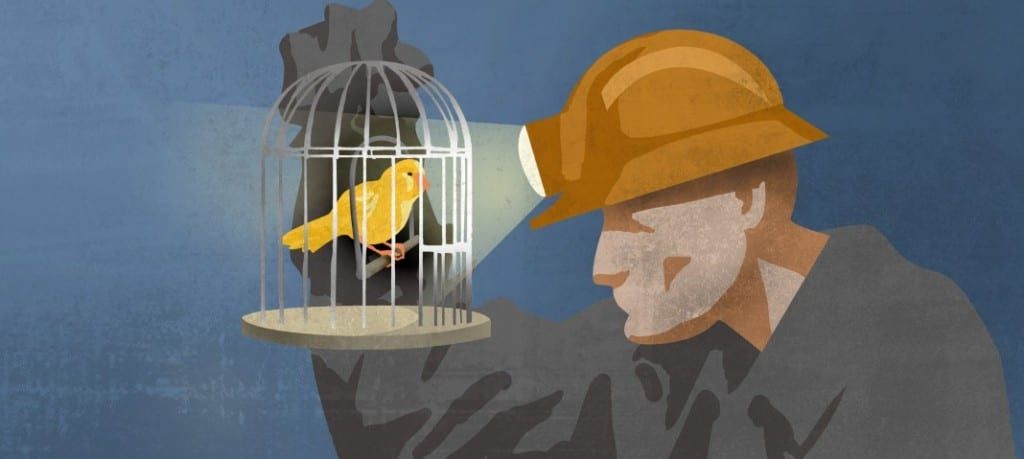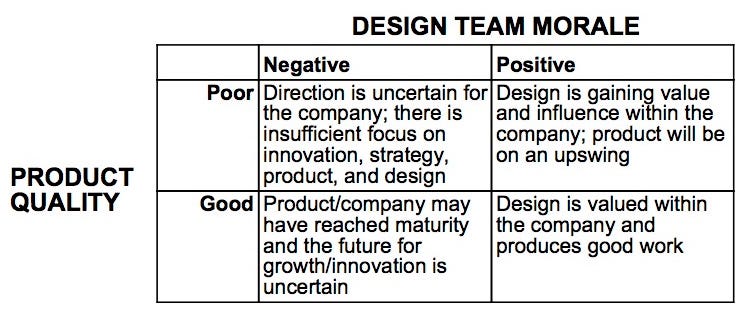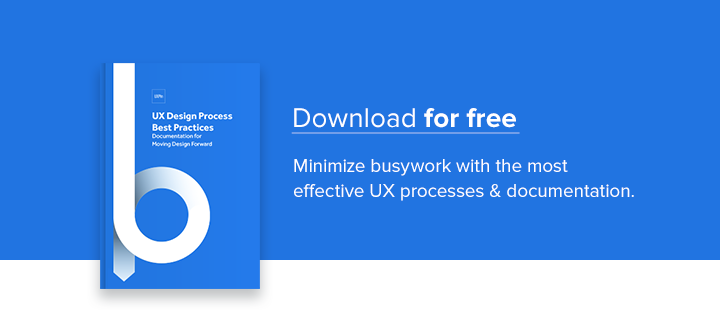Most designers naturally want to join a company where the design of the product is already strong, believing it reflects the value the company places on design and how well designers are set up to succeed.
However, product / design quality is a lagging indicator of companies’ relationship to design and only tells you part of the story. It is equally important to consider leading indicators as well.
Lagging indicators are output-oriented, the results of efforts that were made in the past. They are backward-focused and trailing. Leading indicators, on the other hand, are precursors that help predict the direction something is going.
In public companies, for example, lagging indicators of a company’s health might include net revenue, revenue growth, and return on net assets. Leading indicators might include customer satisfaction, growth in new markets, brand recognition, or number of new patents. Both kinds of metrics are important to consider when evaluating how well a company is doing and where it’s headed. Similarly, lagging and leading indicators for product and design can help guide what companies need from design and what CEOs can do to turn design around within their companies.
When it comes to assessing a company’s relationship to design, it really boils down to two things: (1) design team morale and (2) product quality.
Design team morale is a leading indicator for a company’s design health. Are the designers in the company positive and happy, or do they complain about feeling disempowered or disenfranchised? Product quality is a lagging indicator for a company’s design health, because it reflects all the actions, decisions, and processes the company makes, from the CEO and throughout the organization.
The morale of a UX team is a canary in a coal mine because everything a company does and is impacts the end user experience — the strategy, scope, process, and talent all manifest in the design.

Photo credit: Doug Thompson via Share America
Yet the design team often feels the least empowered to fix the experiences they’re responsible for designing. If designers are not happy, it likely reflects larger issues with the company that impact current and future products under development. Moreover, if designers are not happy, it’s really hard for them to create a joyful experience.
You can chart the relationship between design team morale and product quality into a 2×2 box to infer where things are at and what is needed:

Let’s take a look at each box and what it means:
Design team morale is negative; Product quality is poor
Under this scenario, it’s likely that the company lacks a strong vision for what it wants to do and/or how to get there. The product is confused because internally the company lacks clarity. The design team’s morale is low because they don’t feel empowered to solve the company’s problems; the problems go beyond the purview of the design team.
What’s needed from design and the CEO: The company needs a strong vision that senior leadership can communicate and sell to everyone. Design can help shape strategy by making vision tangible and helping leaders understand possible outcomes. In order for this to be possible, there needs to be a healthy, close relationship between the design leader and company leaders. If a clear vision for the future exists, it’s incumbent upon the design leader and CEO to rally the team to see the opportunity ahead and be excited about delivering it.
Within product development teams, designers suffer the most when there is insufficient process. Process can often be overlooked or undervalued within companies trying to move quickly, but a little bit of the right process can help teams move even faster toward the desired goal. Process can keep a team focused by clarifying escalation paths and how decisions get made. The first design created is rarely the best; use process to carve out sufficient time for designers to explore, design, prototype, and iterate.
Design team morale is positive; Product quality is poor
There can be a variety of explanations for this scenario but rarely are designers ever happy to work at a company that is shipping a bad product unless they believe in the future. Under this scenario, the company is likely orchestrating a pivot or change that gives the designers hope.
What’s needed from design and the CEO: Designers are gaining power and influence and need to step up their efforts to get the company aligned in a single direction. They feel support from the CEO and believe they are set up to succeed. Many designers will overlook opportunities at companies in this box because they only focus on the lagging indicator of bad product quality. However, the leading indicator of design team morale suggests that things will soon improve and there is a chance to play a huge role in turning things around.
Design team morale is negative; Product quality is good
It might be surprising to know that a design team’s morale can suffer even when they are shipping products that are well-designed, but it does happen. Under this scenario, the product has likely reached some level of maturity, but the company has stopped innovating, growth is starting to stagnate, and the future is uncertain. The company ships reasonably good products but designers feel they are not helping to move the needle forward significantly.
Another reason for this scenario may be that the designers are overwhelmed and cannot keep up with the internal demand for their skills. They are spread too thin across too many projects.
What’s needed from design and the CEO: The company needs to chart a future beyond the status quo, and design can be instrumental if not crucial. Companies in this box might fund innovation centers staffed with designers to disrupt or augment their current business, or they might fund skunkworks projects which include designers.
Alternatively, if design team capacity is the problem, the team needs strong management: allocate more headcount towards design to keep up with the demand, and prioritize aggressively. Rarely are there ever enough designers to go around. Rather than spread few resources across too many projects, redirect designers’ energy toward working on a few projects really well.
Design team morale is positive; Product quality is good
Everything is running well and people are happy. While the product is successful and there is company growth, positive design team morale reflects opportunities for their growth and development, not stagnation, and such opportunities are typically the outcome of a strong vision for the company and a clear direction for how to get there.
What’s needed from design and the CEO: With growth and success come challenges related to designing at scale and creating a coherent, consistent design. Style guides, design principles, best practices, and codification of design process are important endeavors that enable a design team to stay effective at scale. Engineering can best support such efforts by building front end infrastructure that allows design to be propagated consistently, and product managers help ensure a coherency in the product by prioritizing such “design infrastructure” projects.
What this all means for designers
Designers vetting different job opportunities should pay attention to both the morale of the design team and the quality of the product. Either in isolation will only tell you part of the story, but combined can give you a more complete picture.
Once you have made that assessment, consider what the company needs from design, and decide for yourself whether you want to sign up for that challenge. No single challenge is more or less worthy than the others; everyone’s temperament and appetite for these different challenges vary. The better you know yourself and what kind of work nourishes you, the better equipped you are to choose what makes sense for you.
What this all means for CEOs
For CEOs, design team morale is a both a leading and lagging indicator, because morale is deeply affected by the sum of how the company thinks and acts. If CEOs care about the success of future projects, they need to pay attention to the morale of their design team. Connect with the design team to understand:
- Are the designers proud of the work they create? Do they feel like they can do their best work? Why or why not?
- Does the company have access to all the skills needed to create great design? For example, do they understand who they’re designing for, what they need, how they think and feel? Do they have the skills to create beautiful products? Do they know how to move people through an experience so users feel satisfied and delighted? Can/do designers explore a range of solutions before narrowing in on the best fit for a problem?
- Does the company implement designs with a high degree of fidelity, or is it usually “close enough”?
- Do designers feel they are constantly catching up and servicing requests from stakeholder functions or do they offer equivalent leadership to the rest of the organization?
- Can you attract the best talent in the industry? If designers keep rejecting your company, why do they choose to not join?
- How much pride does the company take in the product or service offered? How does the company prioritize respect for craft vs. getting things done?
- Does the company commit to iteration or do they move on to the next feature and never look back?
- How do design decisions get made? Who decides, and what is the company optimizing for (e.g. quality, speed, ease of implementation, etc)?
With insight into these questions, you can start to uncover the factors that contribute to low design team morale and take steps that will ultimately benefit product quality.
Originally published on Medium.
Editor’s note: For more product advice, check out the free 100+ page guide UX Design Process Best Practices.







